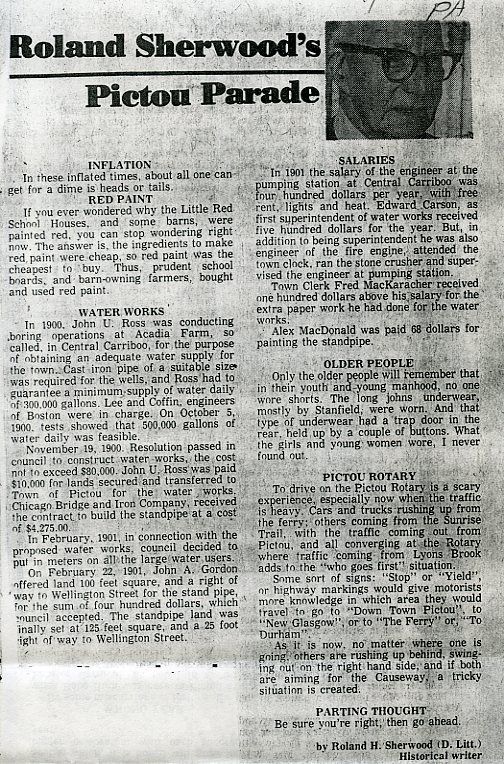
Roland Sherwood’s
Pictou Parade
19/07/78
INFLATION
In these inflated times, about all one can get for a dime is heads or tails.
RED PAINT
If you ever wonder why the Little Red School Houses, and some barns, were painted red, you can stop wondering right now. The answer is, the ingredients to make red paint were cheap, so red paint was the cheapest to buy. Thus, prudent school boards and barn owning farmers bought and used red paint.
WATER WORKS
In 1900, John U.Ross was conducting board operations at Acadia Farm, so called in Central Caribou, for the purpose of obtaining an adequate water supply for the town. Cast iron pipe of a suitable size was required for the wells, and Ross had to guarantee a minimum supply of water daily of 300,000 gallons. Lee and coffin engineers of Boston were in charge. On October 5, 1900, tests showed that 500,000 gallons of water daily was feasible.
November 19, 1900 Resolution passed in council to construct water works, the cost not to exceed $80,000. John U. Ross was paid $10,000 for lands secured and transferred to Town of Pictou for the water works Chicago Bridge and Iron Company, received the contract to build the standpipe at a cost of $4,275.00.
In February, 1901, in connection with the proposed water works, council decided to put in meters on all the large water users.
On February 22, 1901, John A. Gordon offered land 100 feet square, and a right of way to Wellington Street for the stand pipe, for the sum of four hundred dollars, which council accepted. The standpipe was finally set at 125 square feet, and a 25 foot right of way to Wellington Street.
SALARIES
In 1901 the salary of the engineer at the pumping station at Central Carriboo was four hundred dollars per year, with free rent, lights and heat. Edward Carson, as first superintendent of water works received five hundred dollars for the year. But, in addition to being superintendent he was also engineer of the fire engine, attended the town clock, ran the stone crusher and supervised the engineer at pumping station.
Town Clerk Fred MacKaracher received one hundred dollars above his salary for the extra paper work he had done for the water works.
Alex MacDonald was paid 68 dollars for painting the standpipe.
OLDER PEOPLE
Only the older people will remember that in their youth and young manhood, no one wore shorts. The long johns underwear mostly by Stanfield, were worn. And that type of underwear had a trap door in the rear, help up by a couple of buttons. What the girls and young women wore, I never found out.
PICTOU ROTARY
To drive on the Pictou Rotary is a scary experience, especially now when the traffic is heavy. Cars and trucks rushing up from the ferry; others coming from the Sunrise Trail, with the traffic coming out from Pictou, and all converging at the Rotary where traffic coming from Lyons Brook adds to the “who goes first” situation.
Some sort of signs: “Stop” or “Yield”, or highway markings would give motorists more knowledge in which area they would travel to go to “Down Town Pictou” to “New Glasgow”, or to “The Ferry” or, “To Durham”.
As it is now, no matter where one is going, others are rushing up behind, swinging out on the right hand side, and if both are aiming for the Causeway, a tricky situation is created.
PARTING THOUGHT
Be sure you’re right, then go ahead.
By Roland H. Sherwood (D. Litt.)
Historical writer
Vault Roland Sherwood File
| File number: | 01-597.13 d |
| Contributor: |
|
| Tags: | John U Ross, John A Gordon, Edward Carson, Fred MacKaracher, Alex MacDonald, Pictou, Roland Sherwood |
| Views: | 949 |
| Uploaded on: | September 20, 2016 |